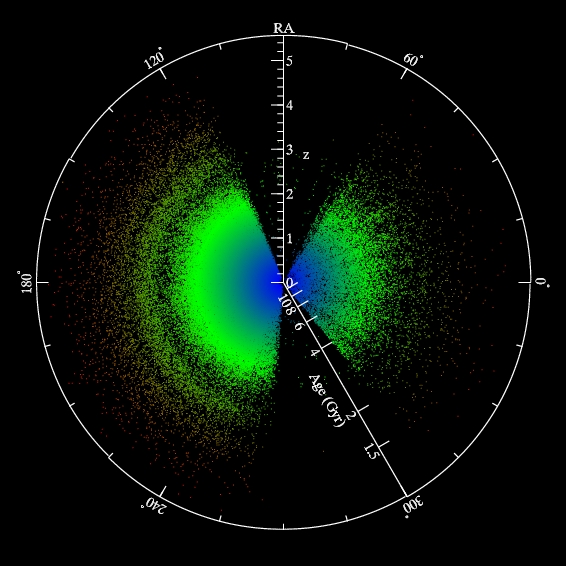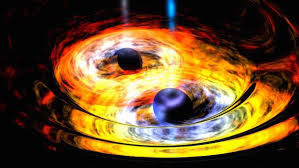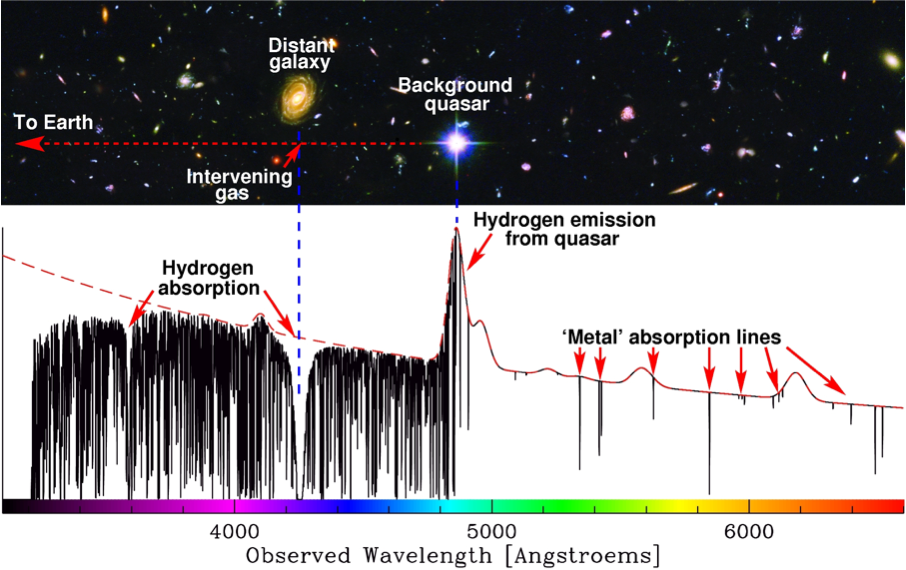Research
My main area is extragalactic astronomy, with an emphasis on active galactic nuclei (AGN) and supermassive black holes (SMBHs). I consider myself a quasarologist for what I spend most of my time on. However, I am generally interested in topics in galaxy formation and observational cosmology, as well as other research topics in data science.
I gratefully acknowledge funding support from the National Science Foundation, NASA, the Alfred P. Sloan Foundation, the Heising-Simons Foundation, and Research Corporation for Science Advancement.
Science
Quasars and Supermassive Black Holes
Quasars and their low-luminosity counterparts AGNs are accreting SMBHs. Because of their high luminosity due to the enormous energy output from the accretion disk, they can be observed up to very high redshift and thereby the very early Universe. These cosmological beacons are by themselves fascinating objects, and beg for an understanding of their formation and evolution in the cosmic landscape. They are also "believed" to have influenced their host galaxies in profound ways during their co-evolution with the hosts, via some feedback processes, the nature of which, however, is still largely elusive at this point.
- Quasar clustering
- Physical properteies of quasars
- Cosmological SMBH models
- Binary SMBHs
- Quasar absorption lines
Quasar Clustering
Just as galaxies, quasars and AGNs as a cosmological luminous population can be used to trace the underlying large-scale structure (LSS) mapped by the invisible dark matter. An important statistical description of the LSS is the two-point correlation function (or clustering for short). I have been working on the measurement of quasar clustering using large, homogeneous quasar samples from the Sloan Digital Sky Survey (SDSS). The strength of quasar clustering tells us about what dark matter halos quasars live in, and quasar clustering has become an important ingredient in cosmological quasar models.
Phenomenology and Physical Properties of Quasars
Quasars are much more than just points in the sky. They have quite diverse properties inferred from their multi-wavelength spectral energy distribution (SED). These spectral properties contain rich information about the physics and astrophysics of the BH, the accretion disk, and other emission regions such as the broad line region. I am working on various aspects of quasar phenomenology, in order to understand quasars and their innermost structures.
Here is my BASI review on the mass of quasars.
Cosmological SMBH Models
With increasingly larger data sets, it has become feasible and important to fit the SMBH population in the cosmological framework, namely, how did the SMBH population evolve across cosmic time. My particular interest on this topic is to investigate how different observations of quasar statistics can be integrated to constrain certain evolutionary models, and how these models make predictions for future surveys.
Binary SMBHs
Most (if not all) astronomers believe that binary SMBHs do exist. Indeed, there have been many reports of spatially-resolved binary SMBHs above pc scales. Under certain circumstances, a SMBH binary will merge to form a single BH. This is an exciting field, not only because numerical GR has been able to predict many interesting phenomena during/after BH coalescence, but also because the data flood in astronomical surveys has enabled systematic searches for these systems/events. If the BBH eventually coalesces, it will produce a gravitational siren that could be detected with ongoing or future low-frequency gravitational wave experiments. In addition, the dynamics of binary SMBHs has always been an interesting topic.
Quasar Absorption Lines
Many quasars show absorption features imprinted on their spectra. These include broad absorption lines (BALs), high-velocity narrow absorption lines (NALs), and associated absorption lines (AALs). Many of the NALs are not physically connected to the quasar, and are simply absorption from cosmologically intervening systems. Intervening quasar absorbers have been a useful tool to study the intergalactic medium (IGM) and high-redshift foreground galaxies, using background quasars. On the other hand, the intrinsic absorber population is a great tool to probe the physical conditions and dynamical processes within the quasar hosts, and carries a key piece of information about the formation and evolution of quasars and massive galaxies. They are as useful as emission lines (even better than emission lines under many circumstances) in the studies of quasar evolution and feedback.
Other Research Interests
I have worked on other topics: hydrodynamics/MHD, solar system dynamics, eccentricity distirbution of exoplanets, and dust aggregate models. I am definitely not an expert in these fields, but it's good to know something outside my main area. Maybe someday I will come back to these topics, when I am tired of quasars :-)
Projects
Below are some specific projects that I am currently working on.
Multi-Object Reverberation Mapping
I am leading a multi-object reverberation mapping project called SDSS-RM, which performs simultaneous photometric and spectroscopic monitoring for a uniformly selected sample of 849 quasars across a wide redshift range (0.1<z<4.5).
Details about the project are on the SDSS-RM website.
Near-IR Spectroscopy of High-z Quasars
I have conducted a near-infrared spectroscopic survey of quasars with existing optical spectroscopy. The near-IR spectroscopy extends the wavelength coverage of quasar Spectral Energy Distribution, and provides rest-frame optical information for high-z quasars. The data are being collected from multiple facilities, including the ARC3.5m/TripleSpec, Magellan/FIRE, and Gemini-North/GNIRS.
Clustering and Demography of Quasars from Surveys
I am using survey data (mostly from SDSS) to constrain the clustering and demography of quasars across cosmic time. With Brandon Kelly, I have developed a framework to measure the 2D demography of quasars in the mass-luminosity plane. The evolution of quasars in this mass-luminosity plane provides critical insights on how SMBHs evolve as a function of time. However, great care is required on the systematics in BH mass estimation and statistical errors when studying the distribution of quasars in the mass-luminosity plane.
Quasar Unification
I am using multi-wavelength data of large statistical quasar samples to understand the unification of quasars. With a unified physical model of quasars, we will not only be able to understand the diverse phenomena of quasars, but also to understand the physics, evolution, and ecology of quasars in the hierarchical universe.


